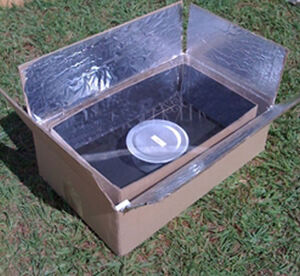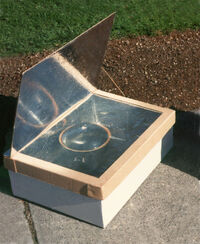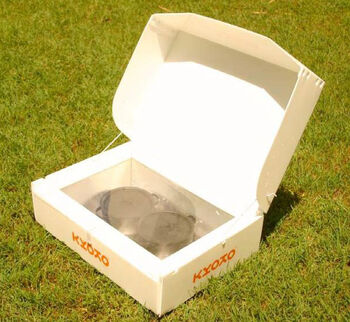
The original Kyoto Box design. See below for updated design.
When Jon Bohmer sat down with his two little girls for a simple project they could work on together, he didn't realize they'd hit upon a solution to one of the world's biggest problems for just $5: A solar-powered oven. Inventor Jon Bohmer with the oven he has made out of a cardboard box.
The ingeniously simple design uses two cardboard boxes, one inside the other, and an acrylic cover that lets in the sun's rays and traps them.
Black paint on the inner box, and silver foil on the outer one, help concentrate the heat. The trapped rays make the inside hot enough to cook casseroles, bake bread and boil water.
[Text copied from http://www.cnn.com/2009/TECH/04/09/solar.oven.global.warming/index.html]
News and recent developments
Design discussion

The "Minimum" Solar Box Cooker uses a single back reflector that is very easily tilted up and down to track the sun instead of tilting the entire cooker as is the case with the Kyoto Box.
This design, while simple, has a number of shortcomings:
- The reflectors will not stay in position with even the slightest wind.
- When the sun is not straight overhead, in order to make use of the reflectors, the entire box has to be tipped up to face the sun. This causes the cooking pot(s) to slide around and spill food.
Rather than have four reflectors, it is much more desirable to have a single rear reflector such as in the "Minimum" Solar Box Cooker design.
Revised design

Probably due the poor cooking performance or the original design, Jon Bohmer has modified the design of the Kyoto Box to be more similar to earlier box cookers. An interesting innovation is the use of a white reflector instead of one covered with aluminum foil or Mylar.
Audio and video
400px
- November 2009: Solar cooking comes of age in Kenya - Al Jazeera
